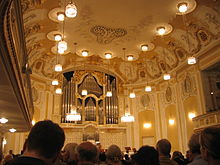- Mozarteum University of Salzburg
-
In Salzburg, the Universität Mozarteum Salzburg, the University of Music and Dramatic Arts Mozarteum Salzburg, honours the Austrian city's most famous son, Wolfgang Amadeus Mozart.
Contents
History
The predecessor of the Mozarteum Orchestra of Salzburg was the "Cathedral Music Association and Mozarteum,” founded in 1841 through the energies of Mozart's widow Constanze Weber Mozart. Its purpose was the “refinement of musical taste with regard to sacred music as well as concerts.” Through the 19th century, the concerts of the orchestra, officially named the "Mozarteum Orchestra" in 1908, became the center of Salzburg’s musical life. The year 1908 also happened to be the year Herbert von Karajan was born in Salzburg. He studied at the Mozarteum and later became a widely recorded and renowned conductor.
In Salzburg, the Foundation built and maintains a building with two concert halls, called the Mozarteum. It was constructed 1910–14, designed by the Munich architect Richard Berndl. (1875–1955).
The "University Mozarteum" is affiliated with the International Mozarteum Foundation. The recently rebuilt "University" main building is located at Mirabellplatz 1.
Grand concert hall organ
The original 100-rank grand concert hall organ was built by the Austrian firm Rieger in 1914. A completely new organ in neo-baroque style was installed in 1970 by E.F.Walcker & Cie. This organ was dismantled in 2008. In 2010 a new 50 stop tracker action organ was installed by Hermann Eule Orgelbau, Bautzen. The original 1914 façade was reconstructed.[1]
Stoplist of 2010 Eule Organ Opus 657[2]I Hauptwerk C–a3 Principal 16' Principal 8' Flûte harmonique 8' Rohrflöte 8' Gambe 8' Octave 4' Flöte 4' Quinte 2 2/3' Superoctave 2' Mixtur major V 2' Cornet V 8' tg Trompete 16' Trompete 8' II Positiv C–a3 Bourdon 16' Principal 8' Bourdon 8' Salicional 8' Bifara 8' tc Praestant 4' Flauto dolce 4' Nazard 2 2/3' Flautino 2' Terz 1 3/5' Mixtur minor IV 1 1/3' Fagott 16' Clarinette 8' Tremulant III Schwellwerk C–a3 Viola d'amour 16' Geigenprincipal 8' Lieblich Gedeckt 8' Fernflöte 8' Aeoline 8' Vox coelestis 8'tc Fugara 4' Traversflöte 4' Piccolo 2' Cornet harmonique III 2 2/3' Progressio II-IV 2 2/3' Basson 16' Trompette harmonique 8' Oboe 8' Clairon harmonique 4' Tremulant Pedal C–g1 Untersatz 32' Ext. Principalbass 16' Violonbass 16' Subbass 16' Octavbass 8' Cellobass 8' Octave 4' Posaune 16' Tuba 8' Clairon 4' Couplers III/I II/I III/II III 16' III 16'/I II 16' II 4'/I III/P III 4'/P II/P I/P Small concert hall organ
The pipe organ in the small concert hall "Wienersaal", invisibly located in an organ chamber above the stage, was built in 1914 by Rieger with 25 stops and electro-pneumatic action. It was rebuilt in 1941, including a new console and some neobaroque modifications. The organ is in bad condition, but still playable.
Notable alumni
- Donald Covert (conductor)
- Herbert von Karajan (conductor)
- Erich Leinsdorf (conductor)
Notable teachers
- Barbara Bonney (voice)
- Veronika Hagen-Di Ronza (viola)
- Leopold Hager (conducting)
- Nikolaus Harnoncourt (conducting)
- Adriana Hölszky (composition)
- Karl-Heinz Kämmerling (piano)
- Angelika Kirchschlager (voice)
- Felix Petyrek (composition)
- Gerhard Röthler (Harpsichord)
- Heinrich Schiff (cello)
- Gerhard Wimberger (conducting, composition)
External links
- Official site
- The Mozarteum - Salzburg Guide
- Mozarteum Orchestra of Salzburg
- Interrnationale Stiftung Mozarteum
- International Mozarteum Foundation website
- Institute for historical and modern-day Mozart Opera Interpretation
References
- ^ http://www.euleorgelbau.de/orgel-aktuell/orgel-aktuell-salzburg.htm
- ^ Allmer, Gottfried: Orgeln im Mozarteum und bei den Salzburger Festspielen, Das Orgelforum, Wien 2010, pages 56-79
Coordinates: 47°48′14″N 13°02′36″E / 47.80389°N 13.04333°E

This article about a music organization is a stub. You can help Wikipedia by expanding it.

